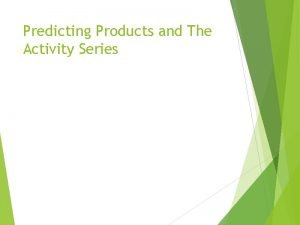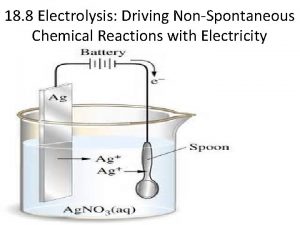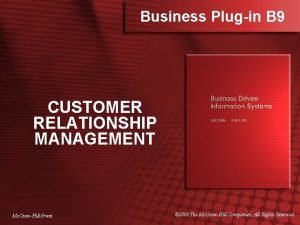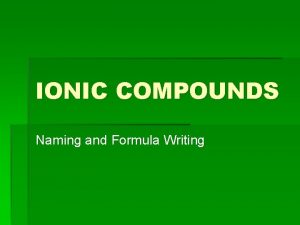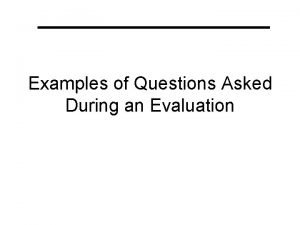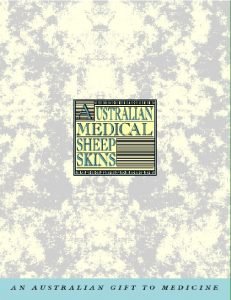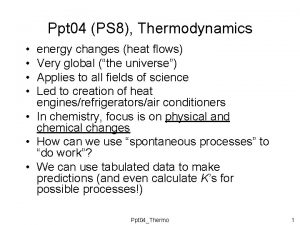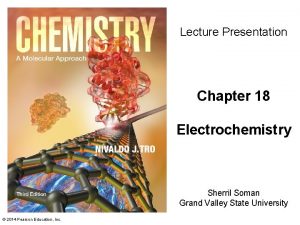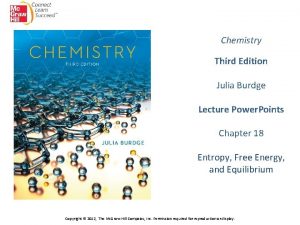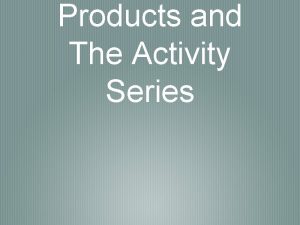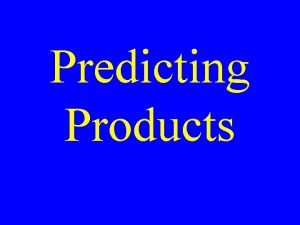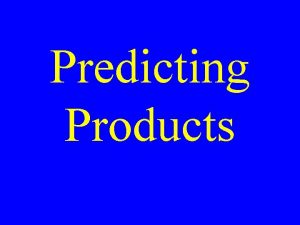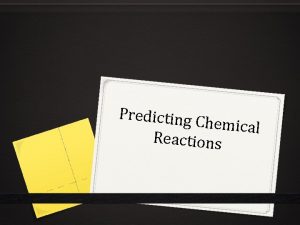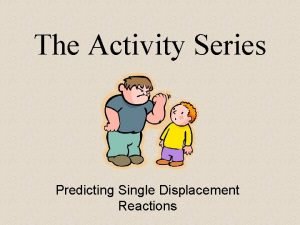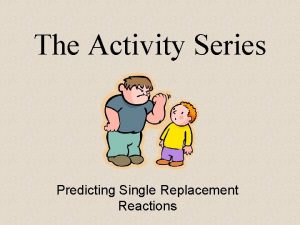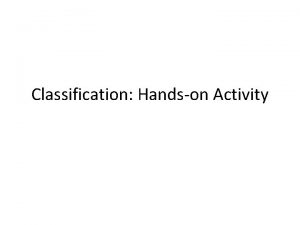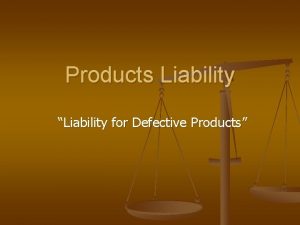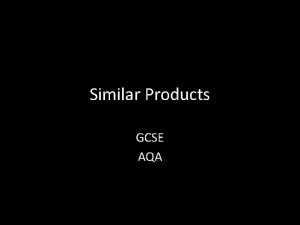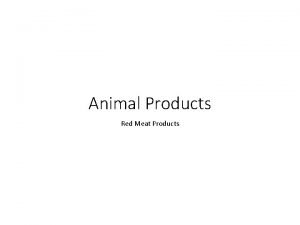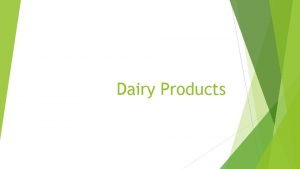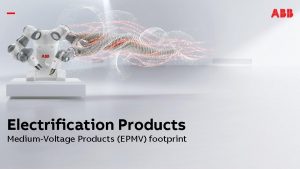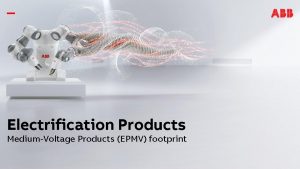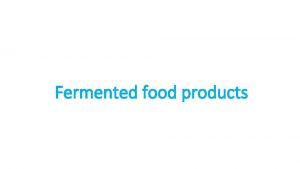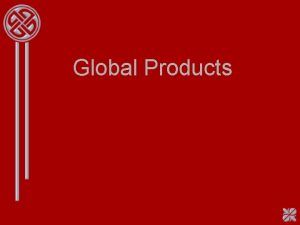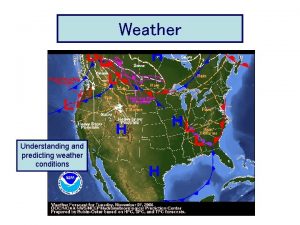Predicting Products and The Activity Series Initial Questions


























- Slides: 26

Predicting Products and The Activity Series

Initial Questions Do all reactions occur? How do you know when a reaction occurs and when it does not? Today we learn about the learn activity series. What do you think the activity series is and what does it mean to reactions?

Objectives Define and explain activity series. Use the activity series to predict is a reaction will occur.

Does it happen or not? ? ? In order to correctly predict the products of a single replacement reaction, the chemical activity of the elements that will potentially switch places needs to be considered. In order for an element to replace another, it must be more active. A more active element will replace a less active element. If this is not the case, then no reaction occurs.

The Activity Series Found on page 437


Which is more active? ? ? For example, for a set of reactants: magnesium and copper sulfate, you need to determine if the magnesium will replace the copper ion. You check the activity series. You find that the magnesium is more active than the copper and therefore the magnesium will replace the copper and the reaction will proceed.

Examples: Will the following reactions occur? products? If no, write NR. 1. chromium + lead (II) chloride 2. zinc + potassium hydroxide 3. magnesium + sulfuric acid 4. iodine + sodium chloride 5. fluorine + sodium chloride If yes, what are the

Examples: Will the following reactions occur? If yes, what are the products? If no, write NR. 1. chromium + lead (II) chloride Yes. Cr. Cl 2 + Pb 2. zinc + potassium hydroxide No 3. magnesium + sulfuric acid Yes. Mg. SO 4 + H 2 4. iodine + sodium chloride No 5. fluorine + sodium chloride Yes. Na. F + Cl 2

Double Replacement Predict the product Recognize if the reaction will occur or not.

Double Replacement Two things replace each other. Reactants must be two ionic compounds or acids. Usually in aqueous solution Na 2 SO 4(aq) + Ca. Cl The positive ions change place. 2(aq) ® Na 2 SO 4(aq)+ Na 2 SO 4(aq) Ca. Cl 2(aq)®Ca+2 SO 42 - + Na+1 Cl-1 + Ca. Cl 2(aq) ® Ca. SO 4(s) + 2 Na. Cl(aq)

To Double Replace or Not to Double Replace? That is the Question? Will only happen if one of the products doesn’t dissolve in water and forms an insoluble solid (s), precipitate (ppt). or or is a gas that bubbles out. water forms, H 2 O (neutralization reaction) .

Initial Questions What does aqueous mean? What are things that are able to form aqueous solution? Generally aqueous reactions are double replacement reactions. What three things drive double replacement reactions?

Does it happen? Deciding whether a double replacement reaction will occur naturally is actually a matter of predicting whether an insoluble product can form. Solubility rules are used to determine this. The solubility rules are a listing of the solubility of various substances in water. Some compounds are listed as soluble and other compounds are listed as insoluble. If one of the products formed is insoluble, it is this insoluble product that is the precipitate that forms in the reaction. If no insoluble precipitate, gas or molecular compound forms then there is no aqueous reaction.

Solubility Rules Can you read the solubility rules? Do you have to memorize them? Which do you need to know by heart? They are on page 434

Solubility Rules Practice Predict whether each of the following will be soluble (aq) or an insoluble ppt (s): KCl Na 2 SO 4 Ca. SO 4 Ag. SO 4 Na 2 CO 3 Mg. S

Solubility Rules Practice KCl(aq) Na 2 SO 4(aq) Ca. SO 4(s) Ag. SO 4(s) Na 2 CO 3(aq) Mg. S(s)

Examples 1. Mix silver nitrate and sodium bromide. Does a reaction occur?

Examples 1. Mix silver nitrate and sodium bromide. Does a reaction occur? Yes - Ag. Br ppt 2. Mix sulfuric acid and barium chloride. Does a reaction occur?

Examples 1. Mix silver nitrate and sodium bromide. Does a reaction occur? Yes - Ag. Br ppt 2. Mix sulfuric acid and barium chloride. Does a reaction occur? Yes - Ba. SO 4 ppt 3. Mix lithium chloride and copper (II) acetate. Does a reaction occur?

Examples 1. Mix silver nitrate and sodium bromide. Does a reaction occur? Yes - Ag. Br ppt 2. Mix sulfuric acid and barium chloride. Does a reaction occur? Yes - Ba. SO 4 ppt 3. Mix lithium chloride and copper (II) acetate. Does a reaction occur? No – everything is soluble

Learning Check Which of the following reactions is double replacement? A. 2 Al(s) + 3 H 2 SO 4(aq) Al 2(SO 4)3(aq) + 3 H 2(g) B. Na 2 SO 4(aq) + 2 Ag. NO 3(aq) Ag 2 SO 4(s)+ 2 Na. NO 3(aq) C. 3 C(s) + Fe 2 O 3(s) 2 Fe(g) + 3 CO(g)

Writing the products

Double Replacement Two elements in reactants take the place of each other AB + CD AD + CB Ag. NO 3(aq)+ Na. Cl(aq) Ag. Cl(s) + Na. NO 3(aq)

Double Replacement Two elements in reactants take the place of each other AB + CD AD + CB Zn(OH)2(aq) + 2 HCl(aq) Zn. Cl 2(aq) + 2 H 2 O(l)

Double Replacement Two elements in reactants take the place of each other AB + CD AD + CB Fe. S(aq) + 2 HCl(aq) Fe. Cl 2(s) + 2 H 2 S(aq)
 Predicting products of chemical reactions
Predicting products of chemical reactions Predicting products of chemical reactions
Predicting products of chemical reactions More predicting products of chemical reactions
More predicting products of chemical reactions Activity series of metals
Activity series of metals Predicting products
Predicting products Predicting products of electrolysis
Predicting products of electrolysis Functional and innovative products supply chain
Functional and innovative products supply chain Pepsi marketing mix
Pepsi marketing mix Bahasa inggris disusun
Bahasa inggris disusun Previewing and predicting
Previewing and predicting The evolution of crm is reporting analyzing and predicting
The evolution of crm is reporting analyzing and predicting Di vs bis
Di vs bis Casey company has five activity cost pools and two products
Casey company has five activity cost pools and two products Series aiding and series opposing
Series aiding and series opposing Initial question examples
Initial question examples Alexandru niculescu-mizil
Alexandru niculescu-mizil Highest braden score
Highest braden score Braden scale for predicting pressure sore risk
Braden scale for predicting pressure sore risk Predicting pip
Predicting pip Predicting pip
Predicting pip Vsepr theory is a model for predicting
Vsepr theory is a model for predicting Single replacement products
Single replacement products Thermodynamics ppt
Thermodynamics ppt Predicting spontaneity
Predicting spontaneity Vertical arrow technique
Vertical arrow technique Predicting spontaneity
Predicting spontaneity Paragraph on scientist
Paragraph on scientist




